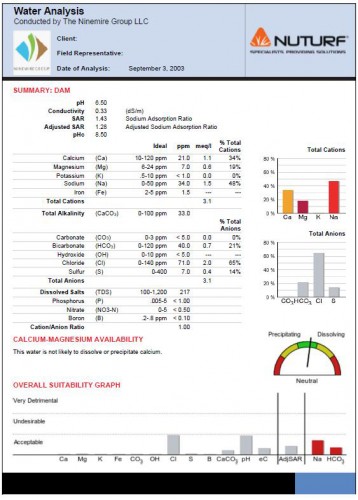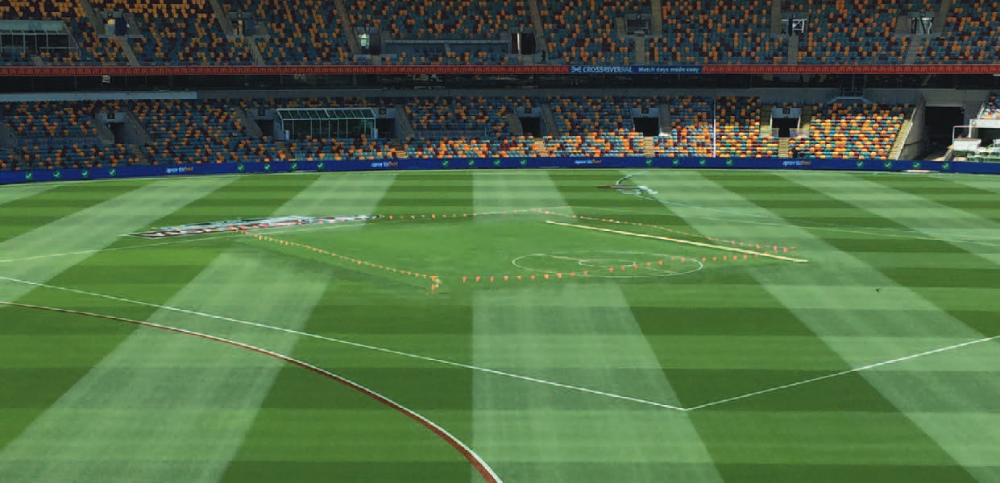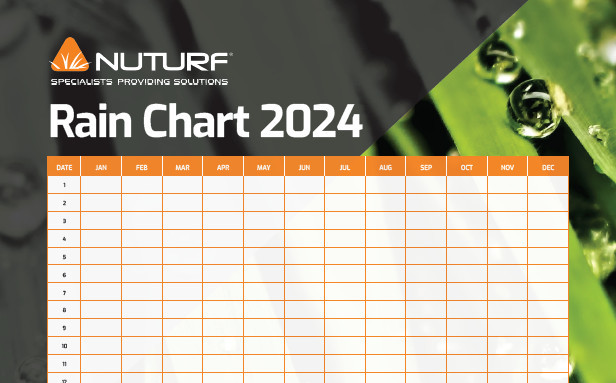How To Determine Nutrient Requirements From Soil Tests & Analyses
A plant (including turfgrass) is only as healthy as its most deficient element (Liebig’s Law of the Minimum). This means that understanding the nutritional limitations present in the soil is of paramount importance in turfgrass management. In order to monitor soil conditions and identify deficiencies we use laboratory soil analysis. Knowing the physical and chemical properties of a soil is critical to the development and success of nutrient, irrigation and renovation programs.

While the soil analysis itself is important, it is the correct interpretation of the results that leads to improvement of soil conditions, in turn resulting in a healthy turfgrass plant. Nuturf’s soil analysis provides the customer with an important tool, offering the flexibility to interpret the results using the method most suited to the specific soil conditions, or simply according to the customer’s personal preferences. This allows the turf manager to make decisions regarding product use with peace of mind, knowing that they can rely on the accuracy of the analysis results.
Two central methods of soil analysis interpretation for making nutrient recommendations are commonly used:
- Base Saturation, and
- Sufficiency Level of Available Nutrients (SLAN).
These are often seen as conflicting methods and many people assume that they must be contradictory approaches unable to work side by side; however in reality both methods can play an important role in soil analysis interpretation.
Provided that the turf manager or consultant has a holistic understanding of these two methods of interpretation they will be able to get the most out of their soil analysis results, giving them the option about which way to manage their nutrition on the differing soil types they may be dealing with.
The Sufficiency Level of Available Nutrients (SLAN) Method
The SLAN method seeks to satisfy a plant requirement for specific nutrients. The level of the nutrient present in the soil is measured through analysis and is compared to an optimal level. The difference between the actual amount and the optimum level is the deficiency. The SLAN method provides a simple calculation to use as a guide for increasing the concentration of a nutrient within the soil, if that is desired.
One of the issues with using SLAN as the sole method of analysis interpretation is that the optimal level of soil nutrient which is used as a target is based on maximizing plant yield. This is excellent in agricultural situations where yield can be measured and used as a target. However in turfgrass, rarely is maximising yield the objective and promoting accelerated growth usually results in a number of turf maintenance issues that negatively affect the playing surface, especially in a golf green situation.
It should also be noted that the cation exchange capacity (CEC; number of negatively charged exchange sites within the soil to hold onto applied nutrients) could be a limiting factor to increasing nutrient concentrations through SLAN, since if there is no soil exchange sites available the applied nutrient will be rapidly leached out of the root-zone and no appreciable increase will result.
The Base Saturation Method
The base saturation percentage refers to the balance of the cations (positively charged nutrients) within the soil. The most abundant soil cations (nutrients) are calcium (Ca), magnesium (Mg) and potassium (K). While the extraction determines the concentration of each cation, it is the balance of these cations that is the focus in this method (both concentration and balance should be considered as important). The percentage of each cation will determine whether a soil is nutritionally balanced.
The SLAN method alone only considers satisfying plant demand for a nutrient, but does not consider the overall soil environment that the plant (turf ) is growing in, and is therefore only half the story.
The Base Saturation method of soil analysis interpretation also considers the soil conditions, playing a role in creating a healthy root-zone for sustainable management of turfgrass that requires only limited additional inputs to maintain an acceptable turf quality. Therefore the two nutritional objectives to achieve within a turfgrass soil are; to ensure there is an adequate concentration of key nutrients in the soil reserve to satisfy turfgrass demand and to ensure that the most abundant soil nutrients (Ca, Mg, K) are present in the right balance (Base Saturation), which is the key to healthy root-zone conditions.
Choosing The Right Method For You: Total Exchange Capacity (TEC)
The key factor in determining which method is most applicable to your soil type is the TEC (Total Exchange Capacity) of the soil. Different soil types have widely varying exchange capacities, varying from the low TEC soils used in most USGA profile constructions, up to the heavier soils found in older sports fields and tennis courts.
The TEC of a soil is its ability to absorb and retain positively charged nutrients in the profile. With a low TEC there is a lack of exchange sites for nutrients so many are leached through the profile following application. To increase TEC the use of humus based products will increase the humic colloid in the profile, therefore increasing the exchange capacity.
By empowering the customer to make their own decisions about which approach to take in the interpretation of their results, Nuturf’s soil analysis offers the most comprehensive and flexible turfgrass oriented soil analysis in the market.
Viewing and Interpreting Your Report

When viewing your reports online on www.getresults.nu, the Report Options section to the right allows two important variants in results interpretation. These can be selected and changed whenever the report is viewed.
- Option 1 The Bar Chart: Allows the customer to tailor the bar chart to display either parts per million, base saturation percentage or both, allowing for graphical interpretation of the desired results.
- Option 2 The Deficiency Calculation: This allows the customer to choose whether their deficiencies will be calculation based on parts per million or base saturation percentage.
Example 1: SLAN Interpretation
 In the example soil report, the concentration of nutrient in the soil is extremely low, as is the TEC at 0.8meq/100g. In this situation it would be futile attempting to balance what small amount of nutrient is present, but will be important to increasing the overall concentration of nutrient in the soil. As a general rule of thumb, if the TEC is below about 5meq/100g, then the SLAN method should be used.
In the example soil report, the concentration of nutrient in the soil is extremely low, as is the TEC at 0.8meq/100g. In this situation it would be futile attempting to balance what small amount of nutrient is present, but will be important to increasing the overall concentration of nutrient in the soil. As a general rule of thumb, if the TEC is below about 5meq/100g, then the SLAN method should be used.
By selecting the SLAN option for the deficiency calculation, the amount of generic product required to amend the deficiency will be calculated. It is important to remember though that without available exchange sites in the soil, most of the amendments applied will be lost through leaching. So the first step here will be to increase exchange capacity through the addition of organic matter before working on increasing soil nutrition. Through regular applications of organic amendments to raise the TEC and nutritional amendments to increase nutrient concentration, this soil will begin to mature to a point that base saturation percentage can be considered as the most appropriate method of analysis interpretation.
Example 2: Base Saturation Percentage Interpretation

The second example shows a very different soil type from the first, as it has a higher TEC and a heavier concentration of nutrients than the first example, though is still a common soil to be encountered in sports turf.
In this particular situation, the base saturation percentage options have been selected for both graphical representation and for the calculated deficiency. As the concentration of nutrients present in the soil would already be considered adequate for plant growth, it is the balance, not the concentration of these nutrients that should be the main focus. With the deficiencies calculated on the ideal balance of soil nutrients, applying the recommended amendments will help to balance the soil into the desired nutrient ratios.
Regular soil analysis and amendment applications calculated from the reported deficiencies will eventually see this soil develop the desired balance of cations, and as a result develop the ideal chemical and physical characteristics most suited to sustained and healthy turf growth.
RECOMMENDED SERVICES
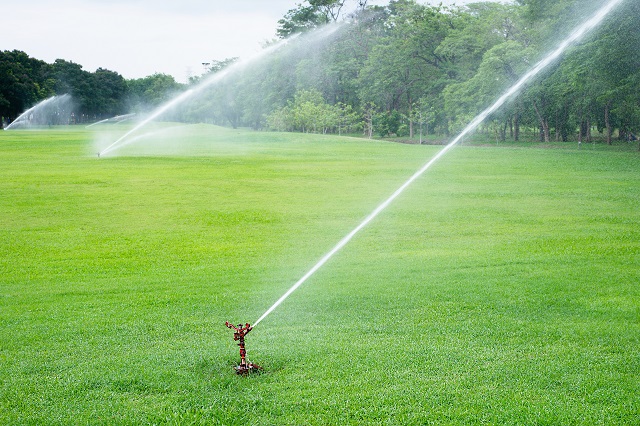
Managing Soil Moisture: The Evolution of Wetting Agents
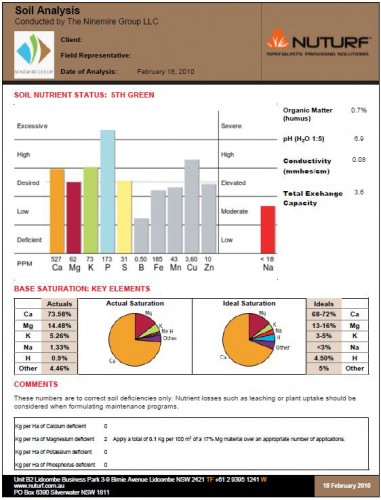
Ninemire Soil Report
